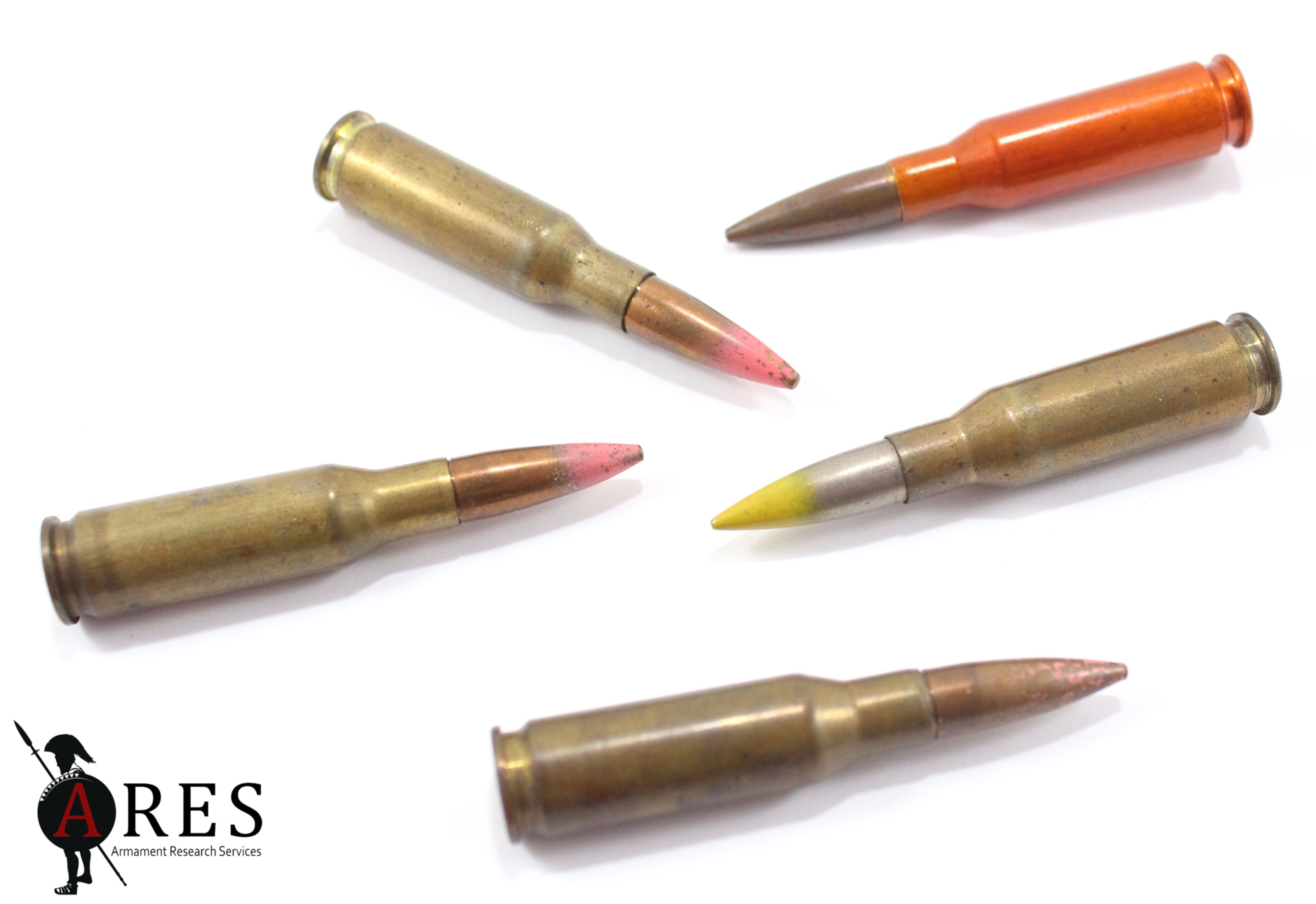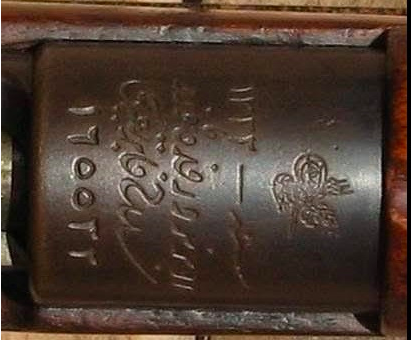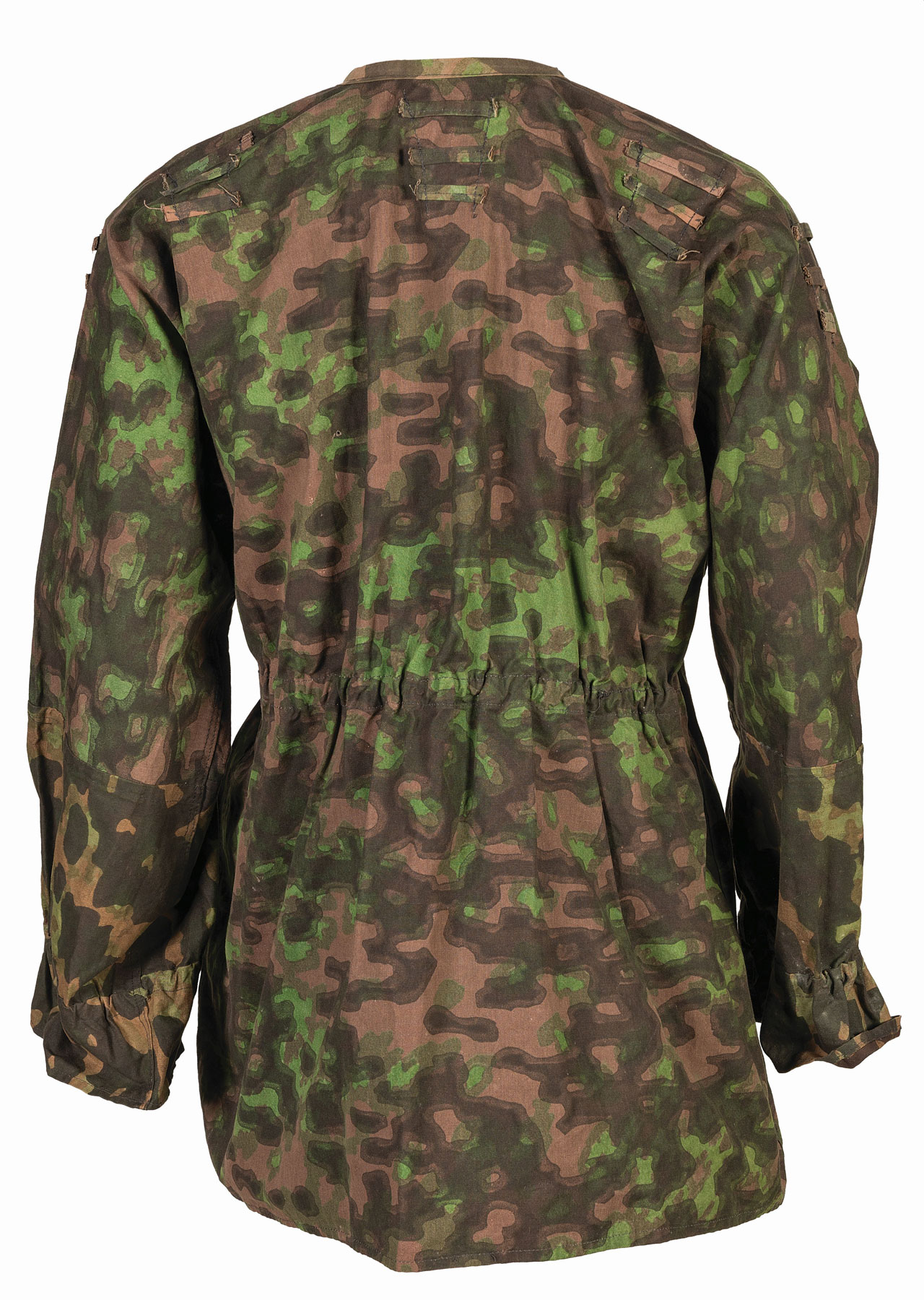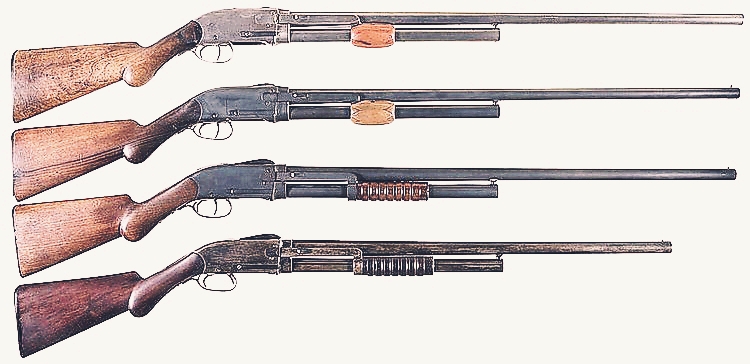History & Statistical Analysis
By Bert Hartman #6571L

The Model 1893 Exposed Hammer Slide-Action Repeating Shotgun was the second John M. Browning designed and patented shotgun manufactured by the Winchester Repeating Arms Company. Production of the Model 1893 began in the spring of 1893, with serial numbers 1– 22 passing through the Polishing Room on May 2nd, 1893. The Model 1893 was formally introduced to the shooting public almost a full year later in the April 1894 Catalog No. 52.
The Model 1893 Slide-Action Shotgun was designed and chambered for the 12 gauge, 2⅝ – inch black powder shell only (identical to the Model 1887), and with a 30 or 32 – inch rolled steel, Full choke barrel as standard. Numerous options and special order features were available, and they will be discussed in further detail later in this article.
One of the primary reasons I decided to research and write this article was to dispel several urban myths that persist about the Model 1893 and to correct a fair amount of inaccurate information that has been published about this particular model in the past. So with that in mind, let’s begin:
- Winchester never officially issued a “recall” for the Model 1893 shotgun. What they did do (beginning in early 1901 based on the factory ledger records), was to voluntarily offer to replace any Model 1893 shotgun returned to them with a brand new Model 1897 shotgun—but only if the customer desired to do so. As of this time, I have yet to find any verifiable document published by Winchester that supports the “recall” theory. None of the original period catalogues make any mention of a “recall”.
-
It is very commonly believed within the collecting community that “most” of the Model 1893 shotguns were returned to Winchester, scrapped, and replaced with a Model 1897 shotgun. I can positively tell you that was not the case! A number of years ago during one of my annual research trips to the Cody Museum, I spent an entire week carefully going through the factory warehouse ledger records looking for information in regards to just how many of them were actually returned and replaced. At the same time, I also verified exactly how many Model 1893 shotguns were manufactured. What I discovered, was that of the 34,179 Model 1893 shotguns that were manufactured, precisely 2,219 of them are listed as being returned and replaced with a new Model 1897, or were returned and “broken up” or “scrapped”. That works out to just 6.49% of the total production that was actually removed from the market.
The original factory warehouse ledger records show that the very first Model 1893 shotgun returned and replaced (by date) was serial number 26836 on 3/26/1901. There were hundreds of earlier serial numbers that were returned and replaced, but all of them were returned at later dates.

Note the “R&R 3/26/1 #93615 see gun # 128141 (Mod. 97)” in the remarks column of the ledger for s/n 26836.

The ledger entry for s/n 128141 has “see gun # 26836 & ticket # 93615”
Above are scanned copies of the ledger pages showing the entries in the records for serial number 26836 and serial number 128141 (courtesy of the Cody Firearms Records Office).
-
So, you are now probably asking yourself: If only 2,219 of the 34,179 Model 1893 shotguns were replaced, where are all of the rest of them now? That is a very good question, and one that more than likely cannot ever be completely answered. That stated, the following paragraphs are a few of my thoughts on that question:
- In my ongoing research survey of the Model 1893, I have thus far located 263 of the 34,179 guns, which is a relatively small number. A notable number of the guns I have located thus far were not found in the United States, which leads to my next supposition.
- Apparently, Winchester exported a substantial number of Model 1893 shotguns to foreign countries and buyers, which makes finding them today considerably more difficult. I have estimated that approximately 10% of the total production was exported, or in numerical terms, approximately 3,418 guns. The Belgians imported a fair number of Model 1893 shotguns based on their association with John Browning.
- As for the remaining 90% of the production, I suspect that at least several thousand of them are still out there sitting in closets, gun cabinets, barns, attics, etc., in poor condition, hence we are not seeing them brought into the collector market. This same scenario exists for the Model 1887 shotgun, which had a much larger production of 67,000+ guns, was never “recalled”, but today we see relatively few of them as compared to their contemporary Winchester rifle cousins. Let’s estimate this category to be 25% of the total production (8,544 guns).
- The survival rate for the older black powder shotguns might actually be significantly lower than we currently believe, thereby eliminating many thousands of them from the collector market. I have estimated the survival rate to be 50% of the total production, which would eliminate 17,089 guns. Some past authors have estimated a much more dire survival rate, as low as just 25%.
- It is also quite probable that a small number of the guns that were returned to Winchester did not get recorded in the original warehouse ledger records. Based on the information that I found in the factory warehouse ledger records, Winchester first began replacing Model 1893 shotguns with Model 1897 shotguns in March of 1901, and ceased doing so in May of 1919. There are several more guns that were returned later in 1919 that are listed as “Broken up” with no replacement Model 1897 serial number listed. There are no entries that I found later than December 1919. Considering the fact that Winchester kept what appears to be very good records for the returned and replaced Model 1893 shotguns for more than 22 years after production had ended, I personally do not believe that more than a few dozen returned guns may not have been entered in the warehouse ledger records. However, and just for arguments sake, let’s assume that 1% of them were not recorded as being returned and replaced (342 guns).
- When we add up the estimated percentages and corresponding numbers from the previous paragraphs, the total is 92.5% (or 31,615 guns) that are out of the reach of the collector market, leaving just 2,563 of them out there that are available to be bought and sold at auctions and gun shows. That is certainly not a very large number! I suspect (based on my survey results) that as many as 20% of the total production are still out there somewhere.
OK, let’s get back to the verifiable production history. John M. Browning and his brother Matthew S. Browning were granted Patent No. 441,390 for the Model 1893 on November 25th, 1890.
As listed in the April 1894 Catalog No. 52, there were just two variations cataloged: (1) the Repeating Shotgun, and (2) the Fancy Repeating Shotgun. Shortly after production began, a Riot Gun was manufactured, but it was never officially listed in any of the ensuing catalogs. Still later, a Trap Gun and a Pigeon Gun were added, but again, they were never cataloged. They are very rarely found today.
Serialization of the Model 1893 began with number 1 on 5/2/1893, and it ran through number 35402 on 7/22/1897 (the last Model 1893 listed in the ledger records). When the successor Model 1897 was introduced in June of 1897, the serialization for it was a continuation of the Model 1893 number sequence. Beginning at s/n 34150, there is a relatively brief intermixing of Model 1893 serial numbers with the Model 1897 serial numbers.
During the 4+ year production run, a number of design changes were made, and with them, Winchester changed the serial number marking to include an “A” above the serial number, and later a “B”. The serial number transition point from no letter to the letter “A” was in the 13800 – 14700 range. The transition from the “A” to a “B” was in the 23550 – 24600 serial range. Very near the end of the production, a final design or production change was made, and a “star” symbol was added. This change occurred near s/n 30000, and it was common until the end of production.
In my ongoing research of the Model 1893, I have discovered that at least three guns were modified by Winchester before they originally shipped or during an R&R, that have both an “A” and a “B” marked on them. All three were originally “A” series guns, but were later altered and have the “B” added above the “A” or below the serial number.






 The “A” added above the serial number indicates that Patent No. 487659 was incorporated. That patent changed the breech locking system such that it required a slight forward movement of the slide handle to unlock the action. On the early production series guns (pre-A), the action could be unlocked (opened) with a simple rearward pull on the slide handle if the firing pin was depressed, or if the hammer was fully down (resting on the firing pin). As of this time, I do not know what the specific mechanical or design change was that Winchester made that necessitated the addition of the “B” or the “star” above the serial number. If any of you who read this know the answer, please get in touch with me.
The “A” added above the serial number indicates that Patent No. 487659 was incorporated. That patent changed the breech locking system such that it required a slight forward movement of the slide handle to unlock the action. On the early production series guns (pre-A), the action could be unlocked (opened) with a simple rearward pull on the slide handle if the firing pin was depressed, or if the hammer was fully down (resting on the firing pin). As of this time, I do not know what the specific mechanical or design change was that Winchester made that necessitated the addition of the “B” or the “star” above the serial number. If any of you who read this know the answer, please get in touch with me.


Right: One other point of interest concerning the production changes that necessitated the serial number letter changes was addressed by Winchester in their catalogs. Specifically, Winchester published separate disassembly instructions based on the letter marked on the receiver frame. This is a scanned copy of the instructions as contained in several Winchester catalogs.

Standard barrels were made of cold rolled fluid steel. Special order barrels in 3-blade (Good) or 4-blade (Fine) Damascus were available, but were rarely ever ordered. In my research of the warehouse ledger records, I found just (424) guns that are listed with a Damascus barrel. That equates to just 1.24% of the total production. Note that the standard barrel markings shown above were rolled stamped right into the Damascus steel.
Unless specified, all barrels were choked Full (unmarked), but could be furnished at no extra cost with a Modified choke or Cylinder bore if so ordered.
Two standard barrel lengths were listed: 30 and 32-inch. Ultimately, many different barrel lengths were made on special order, from as short as 16.5 inches up to 31 inches. The table below shows the production numbers for the more common lengths found.
Barrel Length |
Quantity |
Percentage |
20” |
586 |
1.71% |
21” |
19 |
0.06% |
22” |
43 |
0.13% |
24” |
9 |
0.03% |
26” |
113 |
0.33% |
27” |
6 |
0.02% |
28” |
413 |
1.21% |
30” |
24,077 |
70.45% |
32” |
8,540 |
24.99% |
Other |
22 |
0.07% |
Blank |
351 |
1.02% |
Total |
34,179 |
100.00% |
There were just two different barrel markings that were used. The Type 1 is found on the Pre “A” series guns, and the Type 2 marking was coincident with the introduction of the “A” series.
Type 1 Barrel Marking:
“PAT. NOV. 25. 1890.”

The Type 2 address marking added a second patent date of “DEC. 6.1892.” This marking was used through the end of production. The second patent date was for Patent No. 487659, which corresponded to the letter “A” above the serial number.
Type 2 Barrel Marking:
“PAT. NOV. 25. 1890 & DEC.6.1892.”

Just one style of slide-bar marking was used as shown below:

The sling bar and ring on a Model 1893 Riot Gun

As listed in the April 1894 catalog, the standard Model 1893 shotgun was $25.00, and the Fancy grade was $62.00. The following special order features and associated costs were also listed:
- Fancy Walnut Stock and Fore-arm, not checked … $10.00
- Checking Stock $5.00
- Extra Length or Drop of Stock, to order $10.00
- Rubber Butt Plate $2.00
- Good (3 blade) Damascus Barrel $15.00
- Fine (4 blade) Damascus Barrel $20.00
The standard butt stock used a smooth steel plate with a widow’s peak at the top. A black hard rubber butt plate with the Winchester Repeating Arms Company logo was a special order item.
Pistol grip butt stocks were standard (with the round knob). An English style straight grip butt stock was made for a small number of guns as a special order item.
There were three “carbine” style Riot Guns that were factory fitted with a sling bar and ring.
As previously mentioned, Winchester did manufacture several other variations of the Model 1893 that were not cataloged. A complete survey of the Model 1893 ledger records revealed the numbers shown at the upper right.
Variation |
Quantity |
Percentage |
Standard |
33,096 |
96.83% |
Riot Guns |
644 |
1.88% |
Fancy |
382 |
1.12% |
Elliot (Trap) |
45 |
0.13% |
Trap Gun |
8 |
0.02% |
Pigeon |
4 |
0.01% |
Total |
34,179 |
100.00% |
Riot Guns |
Quantity |
20” Barrel |
583 |
21” Barrel |
19 |
22” Barrel |
42 |
Total |
644 |
As can be seen, there were only 1,083 non-standard Model 1893 shotguns made, and of that number, more than half of them were Riot Guns.
The “Elliot” guns listed in the warehouse ledger records were actually a specific configuration of the Trap Gun. They featured a straight grip (English style) butt stock, oil finished checkered stocks, rubber butt plate, 13 ¾ inch LOP, and a 2 ¼ in Drop at heel. One of the four Pigeon grade guns is listed as “Elliott”.
Another rarity in the Model 1893 was factory engraved guns. Serial numbers “1” and “2” are listed as “Fine Damascus, Checkered stock, Rubber butt plate, Engraved $15.00, Gold receiver”. Those two guns were undoubtedly used to help Winchester promote the Model 1893 at Expositions and similar events. Their whereabouts today are unknown.
Any Model 1893 shotgun found these days in decent factory original condition is a real find, and it is most certainly a highly collectable Winchester. Those that are found with factory special order features are truly rare!
For those of you who own a Model 1893 shotgun, I would very much appreciate hearing from you so that I can add it to my research survey. Win1885@msn.com, or (360) 881- 0272 (evenings, Pacific Standard Time).
Happy hunting and collecting to all,




i also keep a list of a specific gun(burgess shotgun)so i figured id give you info on mine…..In case you want to add it to your list, i have recently bought a Win 1893. Its is #24059 with “A” above serial, checkered forend, semi pistol grip stock, 30-32″ barrel, bought for $675 from hibid auction